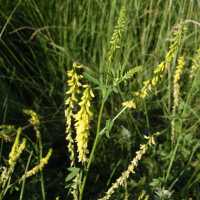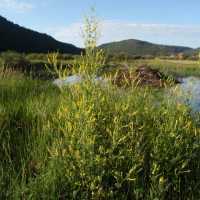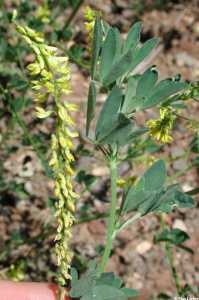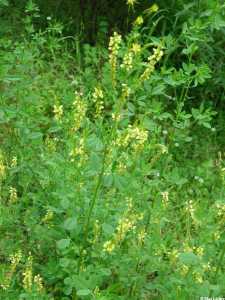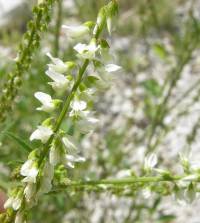This species has been sown for pasture and fodder and has abundantly escaped in all parts of the state to roadsides, railroads, waste places, and fields. [Deam notes that the yellow form also] has been sparingly sown for pasture and fodder and has escaped like the preceding species [Melilotus alba] but it is much more aggressive.
Duration: Perennial
Nativity: Non-Native
Lifeform: Forb/Herb
General: Annual to biennial herbs, 50-150 cm tall, from short rhizomes and a deep taproot; stems in a cluster of up to 10 per plant, erect, glabrous to strigose.
Leaves: Alternate along the stems, on short petioles; leaves pinnately compound with 3 leaflets per leaf; leaflets oval, 1-4 cm long, slightly toothed.
Flowers: Yellow, in racemes 2-14 cm long; flowers 4-7 mm long, with pea-flower morhology (papilionaceous); calyx bell-shaped, the fused portion 1-2 mm long, topped with 5 pointed teeth 1-2 mm long; corolla yellow, fading to a cream color.
Fruits: Pods 3-5 mm long, plump, cross-ribbed; containing 1 or 2 seeds.
Ecology: Found in roadsides, waste places, floodplains, agricultural fields, and pristine areas; from all elevations up to 11,000 ft; flowers May-frost.
Distribution: Native to Eurasia and naturalized throughout the world; throughout N. Amer. and in every state in the US.
Notes: Tall, sweet-smelling erect biennial with many-flowered racemes containing tiny yellow flowers. M. alba has white flowers, but is otherwise very similar in growth form and is often found growing with M. officinalis. M. indicus is a smaller yellow-flowered annual (flowers 2-3 mm long). Eaten by livestock and wild ungulates. Dabbling ducks use it as nesting habitat (mallards, gadwalls, and teals), and many other birds use it for both habitat and food. Host plant for Spring Azure and Eastern-Tailed Blue butterflies.
Ethnobotany: Used medicinally to reduce postsurgical blood clots. Used in tea for soft tissue inflammations. Young leaves have a vanilla flavor and are used in cooking and tea. Herb is used to flavor Gruyere cheese. The nectar is Important for honey production in the US.
Etymology: Melilotus is from Greek meli, honey and lotos, a leguminous plant; officinalis means it is sold as an herb.
Editor: SBuckley 2010, FSCoburn 2015, AHazelton 2015, AHazelton 2017
Ascending or erect, taprooted biennial (annual) 0.5-1.5(-2) m; lfls oblanceolate to obovate, 1-2.5 cm; racemes 5-15 cm (peduncle included); pedicels 1.5-2 mm,
decurved; fls yellow, 4.5-7 mm, the wings about as long as the banner; cal-teeth narrowly lanceolate, subulate; ovules 4-7; fr glabrous, 3-5 mm, strongly cross-ribbed; seeds usually 1 or 2; 2n=16. Native of Eurasia, established as a weed of waste places throughout our range, w. to the Pacific, not common southward. Summer.
Gleason, Henry A. & Cronquist, Arthur J. 1991. Manual of vascular plants of northeastern United States and adjacent Canada. lxxv + 910 pp.
©The New York Botanical Garden. All rights reserved. Used by permission.



